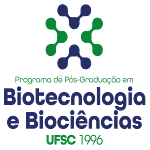Concentration areas and lines of research
Diagram of the PPGBTC concentration areas and lines of research (updated in December/2019)
Prospecting and development of bioproducts
The area has an outstanding role in prospecting and developing new bioproducts and bioprocesses applied to agriculture, animal and human health, cosmetics, food, and environmental sustainability, as well as in the application of biotechnological products for environmental bioremediation
LR: Bioprocesses applied to industry and to One Health
This line focuses on prospecting and characterizing bioactive compounds to develop and optimize products and processes that meet the needs of industry and society regarding human, animal and environmental health. Research in this line involves obtaining and producing bioactive molecules such as enzymes, heterologous proteins and antibiotics, and developing vaccines. In the industrial context, the line of research includes the development, scaling and optimization of bioprocesses applied to the production of biological inputs and biofuels.
LR: Bioprospecting and bioremediation
This line of research aims to develop innovative solutions for solving complex environmental problems. In this sense, bioprospecting aims to explore biodiversity and genetic resources. At the same time, bioremediation seeks to manage contaminated areas through customized solutions for identifying liabilities and assessing and containing risk, with a strong appeal for the use of biotechnologies for environmental remediation.
Host-microbe interaction
Study of pathogenic or commensal microorganisms and their interactions with vertebrate and invertebrate hosts or plants at different levels of complexity, using viruses, bacteria, protozoa, and fungi as models. The discoveries in this area of concentration foster the basic science that permeates biotechnology and the development of innovative solutions for diagnosing, establishing prognostic markers or curing diseases caused by these pathogens.
LR: Mechanisms of host-microbe interaction
The studies aim at the cellular and molecular characterization of the response to pathogenic or commensal microorganisms, emphasizing genetic variability, pathogenicity, virulence, and interaction with the immune system.
LR: Development of biomarkers
This line of research uses data generated from basic science to identify new genetic markers, cellular pathways and processes, and to develop innovative biotechnological solutions for the diagnosis, prognosis or cure of diseases.
Bioinformatics and Systems Biology
This area focuses on research, development and applications of computational methods to understand biological systems based on different biological data generated from different large-scale data generation strategies (omics) to support scientific and biotechnological development.
LR: Complex biological systems
This line aims at the holistic understanding of complex biological systems from the study of the interactions between their components and the interactions that modulate the functions and control the behavior of these systems. To this end, different approaches are used, such as mathematical modeling, data mining, machine learning, network biology, in addition to traditional techniques of molecular and cellular biology.
LR: Computational Biology applied to the omics sciences
This line proposes to study biological models from the use of high-throughput technologies such as genome, transcriptome, proteome and metabolome analysis. It also intends to study the structural and functional composition of environmental, human and animal samples from the analysis of metaproteomic metagenomase. This line of research is the basis for the development of new tools, computational workflows, processing and integration of these biological data that foster analytical platforms for the study of structural and functional genomics of interest to biotechnology-related areas.








